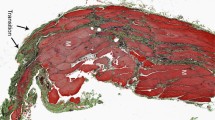Abstract
All standard methods of hernia repair involve suturing together tissues which are not normally in apposition. This violates the basic surgical principle that tissue must never be approximated under tension and thus accounts for an unacceptable number of failures. A total reinforcement of the inguinal floor with a sheet of suitable biomaterial and the employment of a “tension-free” technique is a more effective approach. Since June 1984, 4,000 primary inguinal hernias have been repaired on an outpatient basis and under local anesthesia at the Lichtenstein Hernia Institute by the open “tension-free” technique using Marlex mesh. The patients were followed from 1 to 11 years by physician examination. The follow-up rate was 87%. There were four recurrences. The causes of recurrence and how to avoid them are herein discussed. Three of the recurrences occurred at the public tubercle and were caused by placing the mesh in juxtaposition to the tubercle. This error has since been corrected by overlapping the mesh at the public bone. One recurrence was caused by a disruption of the lower edge of the mesh from the shelving margin of Poupart's ligament. The error here was the utilization of a patch that was too narrow and therefore under tension. It became apparent that a wider patch, fixed in place with an appropriate degree of laxity, was required.
Similar content being viewed by others
References
Brandon WJM (1946) Inguinal hernia: the unpredictable result. Br J Surg 34:13–18
Rand Corp, (1983) Conceptualization and measurement of physiologic health of adults. Santa Monica, p 15
Berliner SD, Burson L, Katz P, Wise L (1978) An anterior transversalis fascia repair for adult inguinal hernias. Am J Surg 135:633–636
Read RC (1992) A review: the role of protease-antiprotease imbalance in the pathogenesis of herniation and abdominal aortic aneurism in certain smokers. Post Gen Surg 4(2):161–165
Wagh PV, Leverich AP, Sun CN, White HJ, Read RC (1974) Direct inguinal herniation in men: a disease of collagen. J Surg Res 17:425–427
Peacock EE (1989) Here we are again: behind again! Am J Surg 157: 187
Lichtenstein IL, Shulman AG, Amid PK (1989) The tension-free hernioplasty. Am J Surg 157:188–193
Amid PK, Shulman AG, Lichtenstein IL (1991) Femoral hernia resulting from inguinal herniorrhaphy: the “plug” repair. Cont Surg, 39:19–24
Duber R (1991) Neuronal plasticity and pain following peripheral tissue inflammation or nerve injury. In: Bond MR, Charlton JE, Woolf CJ (eds) Proceedings of the VIth World Congress in pain. Elsevier, Amsterdam, pp 263–276
Woolf CJ (1989) Recent advances in the pathophysiology of acute pain. Br J Anaesth 63:139–146
Woolf CJ (1991) Central mechanisms of acute pain. In: Bond MR, Charlton JE, Woolf CJ (eds) Proceedings of the VIth World Congress on pain. Elsevier, Amsterdam, pp 25–34
Bugedo GJ, Caramo CR, Mertens RA, Dagnino JA, Munoz HR (1990) Preoperative percutaneous ilioinguinal and iliohypogastric nerve block with 0.5% bupivacaine for post-herniorrhaphy pain management in adults. Reg Anesth 15:130–133
Tversky M, Cozacov C, Ayache M, Bradley E, Kissin I (1990) Postoperative pain after inguinal herniorrhaphy with different types of anesthesia. Anesth Analg 70:29–35
Wantz GE (1991) Atlas of hernia surgery. Raven, New York, p 19
Bays RA, Barry L, Vasilenko P (1991) The use of bupivacaine in elective inguinal herniorrhaphy as a fast and safe technique for relief of postoperative pain. Surg Gynecol Obstet 173(6):433–437
Lichtenstein IL, Shulman AG, Amid PK, Montllor M (1988) Cause and prevention of post-herniorrhaphy neuralgia: a proposed protocol for treatment. Am J Surg 155:786–790
Gatt MT, Chevrel JP (1992) The treatment of neuralgia following inguinal herniorrhaphy: a report of 47 cases. Postgrad Gen Surg 4(2):142–147
Bendavid R (1992) “Dysejaculation”: an unusual complication of inguinal herniorrhaphy. Postgrad Gen Surg 4(2):139–141
Shulman AG, Amid PK, Lichtenstein IL (1993) Ligation of hernial sac a needless step in adult hernioplasty. Int Surg 78:152–153
Smedgerg SGG, Broome AEA, Gullmo A (1984) Ligation of the hernia sac? Surg Cl NA 64:99
Wantz GE (1984) Complications of inguinal hernial repair. Surg Clin North Am 64(2):287–297
Abramson JH, Gafin J, Hopp C (1978) The epidemiology of inguinal hernia: a survey in western Jerusalem. J Epid Commun Health 32:59
Panos RG, Beck DE, Maresh JE, Harford FJ (1992) Preliminary results of a prospective randomized study of Cooper's ligament versus Shouldice herniorrhaphy technique. Surg Gynecol Obstet 175:315–318
Arthur GR, Covino BG (1988) What's new in local anesthetics. Anesthesiol Clin North Am 6:357–364
Shulman AG, Amid PK, Lichtenstein IL (1992) The safety of mesh repair for primary inguinal hernias: results of 3,019 operations from five diverse surgical sources. Am Surg 58:255–257
Barnes JP (1987) Inguinal hernia repair with routine use of Marlex mesh. Surg Gynecol Obstet 165:33–37
Capozzi JA, Berkenfield JA, Cheaty JK (1988) Repair of inguinal hernia in the adult with prolene mesh. Surg Gynecol Obstet 167:124–128
Martin RE, Max CE (1984) Primary inguinal hernia repair with prosthetic mesh. Hospi Medica 1(3):1
Tinkler LF (1985) Inguinal hernia repair using local anesthesia. Ann R Coll Surg Engl 67(4):268
Shulman AG, Amid PK, Lichtenstein IL (to be published) A survey of non-expert surgeons using the open tension-free mesh repair for primary inguinal hernias. Int Surg
Author information
Authors and Affiliations
Rights and permissions
About this article
Cite this article
Amid, P.K., Shulman, A.G. & Lichtenstein, I.L. The Lichtenstein open “tension-free” mesh repair of inguinal Hernias. Surg Today 25, 619–625 (1995). https://doi.org/10.1007/BF00311436
Received:
Accepted:
Issue Date:
DOI: https://doi.org/10.1007/BF00311436




